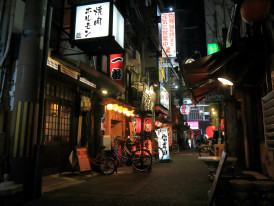
View from a quiet Osaka alley with small signs and moody lighting.
Introduction: A Cool Side of Osaka You Might Miss
I was fifteen when I first realized tourists saw a completely different Osaka than I did. Standing outside Osaka Castle with my visiting cousin from Tokyo, she snapped photos of the reconstructed keep while I noticed the office worker eating convenience store onigiri on a bench nearby.
That moment taught me something: cool places in Osaka aren't always the ones in guidebooks.
After two decades of living here, I've watched Osaka evolve from Japan's scrappy second city into something more polished, yet still wonderfully rough around the edges.
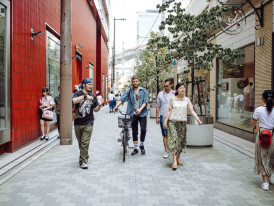
Cyclist passing street mural in hip Osaka neighborhood.
This isn't your typical tourist rundown with a brief focus on Japanese culture and street food. I'm not going to pretend every ramen shop is life-changing or that every shrine visit will transform your soul.
Instead, I'll show you the Osaka I actually love - the one that shows itself when you stop looking so hard for "authenticity" and just start paying attention.
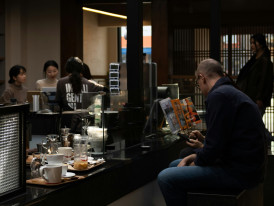
Local businessman reading newspaper at small café in Osaka city center. Image by inyoung jung from Unsplash
The corners where old meets new.
Where locals create culture rather than consume it. Where you can eat incredible food without waiting in line for two hours.
That's what I think of when I talk to friends who want to explore Osaka.
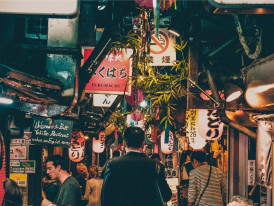
Traditional lanterns hanging in modern alley.
What Makes Osaka Different
Visiting Osaka requires a different mindset than exploring Kyoto or Tokyo. This isn't a city that shows itself through famous landmarks or Instagram-perfect moments.
It's a place that rewards curiosity over planning, appetite over restraint, and conversation over silent observation.
The best experiences happen when you're slightly lost, mildly hungry, and open to whatever presents itself around the next corner.
The Unexpected Icons: Beyond the Postcard Shots
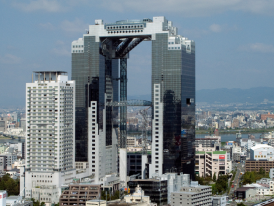
Umeda Sky Building with clouds reflecting on glass.
Umeda Sky Building: Floating Architecture That Still Surprises
Most people photograph the Umeda Sky Building from street level, but the real magic happens underground.
Emerging from Osaka Station passages, the building appears like something that shouldn't exist.
Two towers connected by a floating ring.
The observation deck gets crowded, but here's what visitors miss: basement levels house some of the city's most interesting small bars.
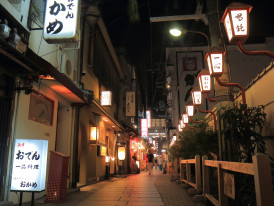
Traditional alley recreation with people walking around.
The Hidden Alley Experience
The Takimi-koji alley recreates a 1960s Osaka street scape.
Yakitori smoke and conversations bouncing off narrow walls. It's how the building functions as a vertical neighborhood that makes it cool.
Office workers grab lunch below.
Tourists take photos above. Locals meet friends in between.
Everything layered on everything else - classic central Osaka.
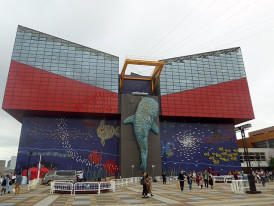
Aquarium entrance with sparse morning crowd. Image by Tokumeigakarinoaoshima from Creative Commons Attribution-Share Alike 4.0
Osaka Aquarium: Where Marine Life Meets Urban Poetry
The Osaka Aquarium Kaiyukan sits on Osaka Bay like a giant blue cube. Honestly, from outside it looks like a shopping mall.
But step inside and you'll understand why this is one of the world's most impressive aquariums.
The spiral walkway takes you through Pacific ecosystems.
The whale shark tank is the obvious star, and a must-see in my opinion.
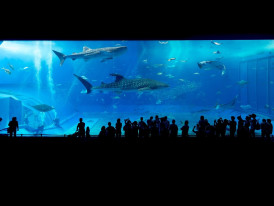
Visitors silhouetted against large aquarium tank.
Ancient Salamanders in Modern Times
I'm drawn to the Japanese giant salamander exhibit. These wrinkled creatures move so slowly they seem prehistoric, which they basically are.
There's something meditative about watching them while the bustling city continues outside.
Visit early morning to avoid school groups. The Osaka Aquarium stays open until 8 PM.
Something surreal about watching jellyfish pulse under artificial lights while the sun sets over Osaka Bay.
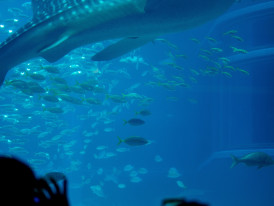
Child watching whale shark at Osaka Aquarium. Image by Anton Lammert from Unsplash
More Than Marine Life
The aquarium offers contemplative space in this incredible city. Children press faces against glass while adults find unexpected Zen moments.
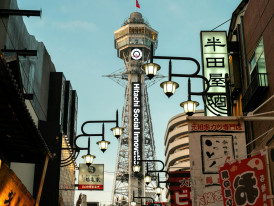
Tsutenkaku at dusk with neon contrast. Image by ghoon from Pexels
Tsutenkaku Tower: Retro Future in Shinsekai
Tsutenkaku Tower looks like 1950s sci-fi, which makes sense.
It was built to represent Osaka's vision of the future. Now it's decidedly retro, standing over chaotic Shinsekai like a benevolent robot overlord.
The tower itself is fine. Decent views, shrine to Billiken (god of things as they ought to be).
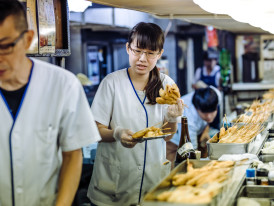
Woman preparing kushikatsu at street stall with neon lights in the background.
The Real Attraction: New World District
But for me, the true draw is the neighborhood. Shinsekai (literally "New World") is old Japan's idea of the future: neon lights, pachinko parlors, restaurants specializing in kushikatsu (deep fried everything on sticks).
This isn't sanitized theme park Japan. It's genuinely gritty, occasionally weird, completely true to itself.
Gorgeous Urban Chaos
Elderly women running tiny bars. Salary men playing pachinko after work.
Tourists tentatively ordering unidentified but delicious food. It all coexists in ways that feel both timeless and distinctly modern.
Street Culture & Neon Nights: Where the City Never Sleeps
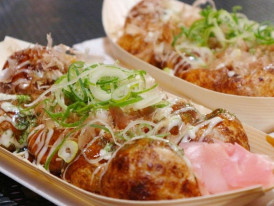
Takoyaki at street food close up in tradional wooden boat.
Namba Station and the Art of Controlled Chaos
This station isn't just transportation, it's the beating heart of Osaka's street culture.
Multiple train stations converge here, creating constant flow feeding surrounding entertainment districts.
Underground shopping areas stretch for blocks, creating a parallel city most visitors never explore.
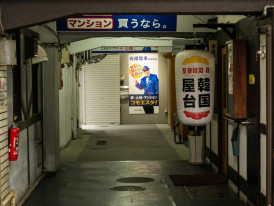
Underground shopping passage with directional signs. Image by Kouji Tsuru from Unsplash
Getting Lost Underground
I've used these passages for years and still occasionally get lost. Something liberating about being temporarily disoriented beneath one of Japan's busiest intersections.
Above ground, Dotonbori's neon lights grab attention, but side streets tell better stories.
Where Creatives Gather
Small bars with hand-written menus. Vintage clothing stores. Record shops specializing in 1970s Japanese jazz. These are places where Osaka Japan's creative community actually gathers.
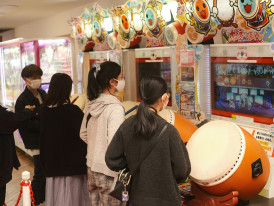
Young Osaka locals gathering near Namba arcade. Image by Perry Merrity II from Unsplash
Covered Shopping Arcades: Retail Therapy with History
Osaka's covered shopping arcades are architectural time machines. Shotengai like Shinsaibashi-suji and Tenjimbashisuji have been commercial streets for centuries.
What makes these shopping arcade spaces special isn't merchandise. You can find similar items anywhere in Japan. It's the rhythm of daily life they contain.
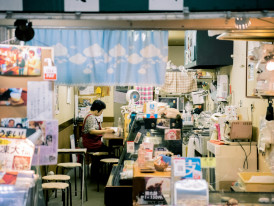
Traditional shopkeeper arranging goods in covered arcade. Image by Satoshi Hirayama from pexels
Daily Life Rhythms
Elderly customers chatting with shopkeepers they've known for decades. High school students window shopping after school. Office workers grabbing dinner ingredients.
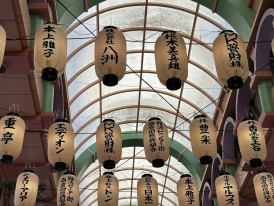
Arcade ceiling with traditional architecture details. Image by Kevin Jeon from Unsplash
Japan's Longest Shopping Street
Tenjimbashisuji-shotengai stretches nearly three kilometers. Walking its full length is like taking a cross-section of Japanese retail culture. Traditional crafts shops to modern chain stores, all under protective roof.
Plus, it's less than 15 minutes from Osaka Castle, giving you another reason to visit both.
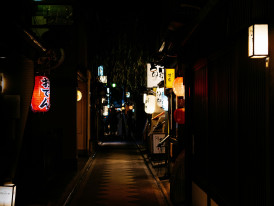
Narrow bar alley with red lanterns at night. Image by Ying Zhu from Unsplash
Vibrant Nightlife: After Dark Adventures
When the sun sets, Osaka City's personality changes. The polite daytime city gives way to something more relaxed, experimental.
This is when vibrant nightlife shows its character.
Ura-Namba bars stay open until dawn, serving everything from craft cocktails to canned beer.
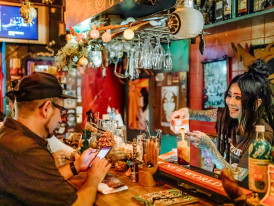
Bartender serving drinks in tiny establishment.
Intimate Bar Culture
Many are tiny - just five or six seats - creating intimacy that forces strangers into conversation.
The bar culture here isn't about impressing anyone; it's about finding comfortable space to drink and talk.
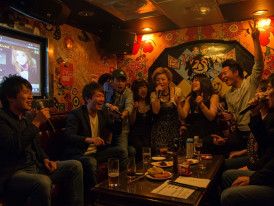
Friends singing karaoke late at night.
Karaoke Culture
Karaoke boxes are everywhere, but the best are older, slightly run-down establishments. Song selection includes enka ballads alongside J-pop hits. Something cathartic about singing Japanese folk songs at 2 AM with people you just met.
Where Design Meets Daily Life: Style Without Pretense
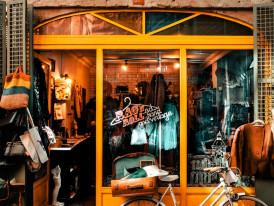
Boutique storefront on Orange Street. Image by Volkan Vardar from pexels
Orange Street: Osaka's Design District
Orange Street (Amemurasuka) runs through Amerika-mura district like a style-conscious thread connecting vintage boutiques, independent cafés, design studios.
Locals call it "Ame-mura" or "American Village." This isn't Harajuku-level fashion experimentation, but something more subtle and wearable.
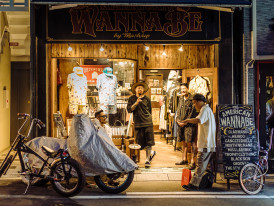
Vintage clothing display in Amerika-mura shop.
Quality Over Novelty
Vintage stores here focus on quality over novelty. Carefully curated collections of 1990s Japanese streetwear, American workwear, European designer pieces that somehow work together.
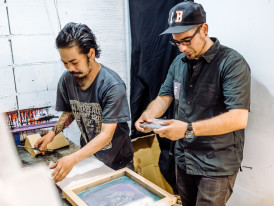
Designer sketching in Orange Street café.
Creative Café Culture
Orange Street cafés serve good coffee, but more importantly, they provide spaces for observation. The clientele skews young and creative: art students, freelance designers, musicians between gigs.
Conversations happen in multiple languages, but the common thread is appreciation for well-made, thoughtfully designed things.
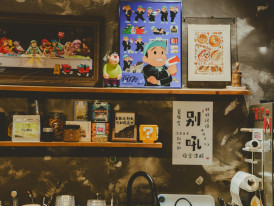
Coffee served at minimalist café close to Osaka station. Image by 王 术山 from Unsplash
Grand Front Osaka: Corporate Architecture with Soul
This could have been another soulless shopping complex attached to Osaka Station, but somehow it works. The building houses everything from luxury brands to casual restaurants.
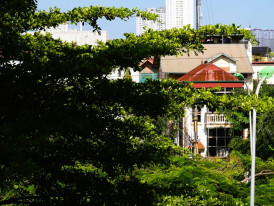
Rooftop garden with city skyline backdrop. Image by Ivy Dao from Unsplash
Unexpected Urban Oasis
The roof garden provides unexpected oasis above urban chaos. Office workers eat lunch here, families let children play, couples meet for coffee dates.
It's not grand like Osaka Castle, but it serves the city as functional gathering place for contemporary life.
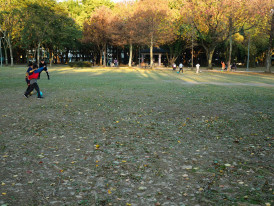
Children playing in Osaka public space. Image by MChe Lee from Unsplash
Multi-Purpose Urban Space
The Grand Front succeeds because it understands modern urban spaces need multiple functions simultaneously. Shopping, working, socializing, relaxing - all within the same architectural framework.
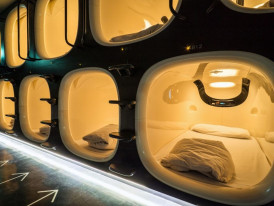
Modern capsule hotel pod interior.
Capsule Hotels: Sleeping in the Future
Osaka's capsule hotels have evolved beyond their original function as crash pads for drunk salarymen. Modern versions offer clean, efficient accommodation feeling more like staying in a spaceship.
Space-Age Efficiency
The capsules are marvels of space efficiency. Everything needed for sleep arranged in spaces smaller than most walk-in closets. Personal TVs, charging stations, climate control, surprisingly comfortable beds.
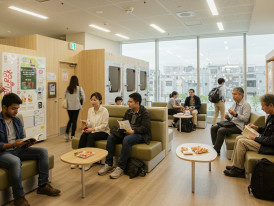
Capsule hotel common area with travelers.
Community Spaces
What makes the capsule hotel experience distinctly Osakan is attention to communal spaces. Lobbies, bathhouses, lounges designed for interaction.
Travelers from around Japan and the world share stories over vending machine coffee at 3 AM, creating connections impossible in traditional hotels.
Food for Thought: Deep Fried, Street-Wide, & Sincerely Local
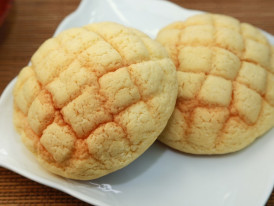
Fresh melon pan.
Street Food Culture: Beyond Takoyaki
Yes, takoyaki is delicious.
Yes, you should try it.
But Osaka's street food culture extends far beyond octopus balls. The most interesting discoveries happen away from main tourist corridors.
Bakery Revelations
I won't give you a big fancy schmancy food tour "Osaka-style," but I have to mention my favorites!
Melon pan from convenience stores is fine, but melon pan from dedicated bakeries is revelation.
The contrast between crispy, sweet exterior and soft bread inside becomes apparent when fresh from the oven.
Some shops add seasonal flavors, cherry blossom in spring, sweet potato in autumn, reflecting Japan's deep connection to seasonal change.
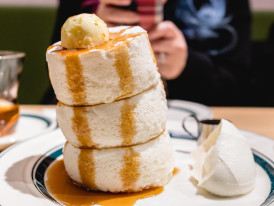
Vendor timing the perfect imagawayaki flip.
Street Performance Food
Imagawayaki (round pancakes with sweet or savory fillings) cook on circular griddles creating perfect golden circles.
Watching vendors flip them at precisely the right moment becomes street performance.
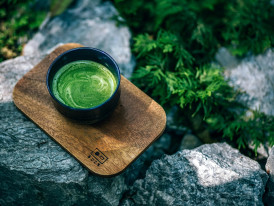
Matcha tea served in rustic setting. Image by NipananLifestyle.com from pexels
Local Food Experiences: Where Locals Actually Eat
Food enthusiasts visiting Osaka often make the mistake of only eating at famous restaurants in guidebooks. But the city's best meals happen in places that don't need to advertise.
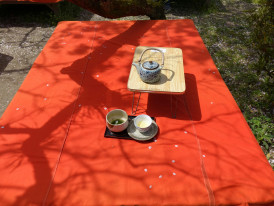
Traditional tea ceremony setup in modern context. Image by Arthur Tseng from Unsplash
Tea Ceremony Meets Daily Life
Matcha tea ceremonies exist in Osaka, but they're different from formal Kyoto versions. Here, tea ceremony culture blends with daily life more casually.
Small cafés serve matcha alongside Western-style pastries, creating combinations that would horrify traditionalists but taste perfectly natural.
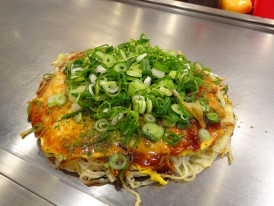
Chef preparing okonomiyaki with generous green onions.
Osaka vs Tokyo Flavors
Sushi rice in Osaka is seasoned slightly differently than Tokyo—a bit sweeter, reflecting local preference for umami-rich flavors. The difference is subtle but noticeable when eating at counters watching chefs work.
The Green Onion City
Green onions appear in everything here. From okonomiyaki to ramen to yakitori. It's such a defining characteristic of Osaka cooking that locals joke about identifying hometown cuisine by scallion abundance alone.
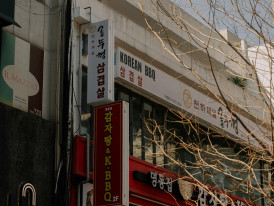
Korean BBQ restaurant in Tsuruhashi district. Image by Elina Volkova from pexels
International Dishes: Global Flavors, Local Twist
If anything warrants a food tour, it's the diversity on offer and so readily available. Osaka's relationship with international dishes reflects the city's pragmatic culture approach: adopt what works, adapt to local tastes, don't worry about authenticity.
Korean Influence
Korean barbecue restaurants in Tsuruhashi serve kimchi less fermented than Seoul-style versions, adjusted to Japanese palates while maintaining essential flavors.
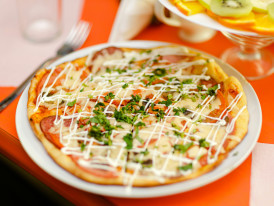
Fusion pizza with Japanese toppings. Image by Игорь Антипов from Unsplash
Chinese Adaptations
Chinese restaurants offer dishes existing nowhere in China but becoming Japanese classics—sweet and sour pork, gyoza crispier than Chinese dumplings, ramen bearing only passing resemblance to Chinese ancestors.
Even Western food gets Osaka treatment. Pizza topped with mayonnaise and corn, hamburgers served with chopsticks, spaghetti with mentaiko sauce.
Day Trips, Ferris Wheels, and Unexpected Peace
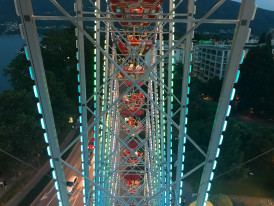
View from top of Tempozan Ferris Wheel. Image by Silvan Metzker from Unsplash
Tempozan Ferris Wheel: Slow Motion Perspective
The Tempozan Ferris Wheel rotates slowly above Osaka Bay, providing different sightseeing experience.
Unlike static observation deck views, the Ferris wheel creates constantly changing perspectives.
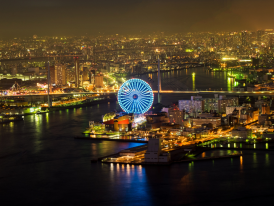
Tempozan Ferris Wheel illuminated against evening sky.
Fifteen-Minute Meditation
Each rotation takes fifteen minutes - long enough for conversation, short enough to maintain interest.
Enclosed gondolas protect from weather while providing 360-degree views putting Osaka's geography in context.
The city spreads inland from the bay in all directions, interrupted by rivers, railways, highways dividing urban area into distinct neighborhoods.
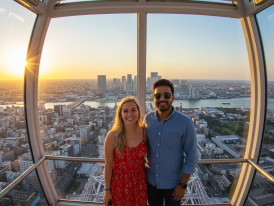
Couple enjoying view from Tempozan Ferris Wheel.
Seasonal Perspectives
The Ferris wheel runs year-round, but different seasons offer completely different experiences. Summer evenings provide views of fireworks festivals over the bay. Winter mornings gives you a look at the city wrapped in fog.
Spa World: International Bathing Experience
Spa World attempts to recreate bathing cultures from around the world within a single building, somehow making it work without feeling like a theme park.
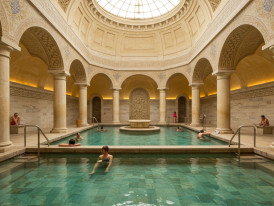
Roman-style bath interior at Spa World.
European and Asian Sections
European spa section features Roman-style baths, Finnish saunas, Turkish hammams. Asian section offers Japanese onsen, Korean jjimjilbangs, Balinese treatments.
The concept sounds ridiculous - who needs a fake Roman bath in Osaka? - but execution is surprisingly thoughtful.
Cultural Integrity
Each area maintains cultural integrity while adapting to Japanese expectations of cleanliness and service. The result: experiencing different bathing traditions without traveling the world.
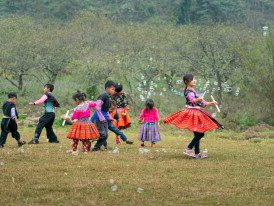
Tempozan village scene with kids playing. Image by Quang Nguyen Vinh from Unsplash
Tempozan Harbor Village: Manufactured Charm That Works
Tempozan Harbor Village was designed to feel like a European port town, complete with cobblestone streets and Victorian architecture. It should feel artificial and wrong, but somehow doesn't.
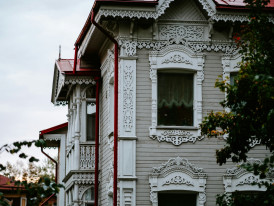
Victorian-style buildings at Tempozan Harbor Village. Image by Andrey K from Unsplash
Real Function vs Pure Attraction
Maybe because the village serves real function - shopping, dining, entertainment - rather than existing purely as tourist attraction.
Families come for day trip excursions combining aquarium, Ferris wheel, shopping in compact area. You can too!
Honest Artificiality
The village works because it doesn't try too hard to be "authentic." Everyone knows it's fake, so there's no pretense to maintain.
Lesser Known Experiences & Real Encounters: Off the Beaten Path
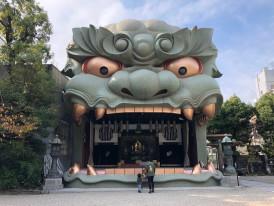
The well-known lion-head shrine.
Namba Yasaka Shrine: Ancient Mysticism in Urban Chaos
Walking through busy streets around Namba Station, you'd never expect to stumble upon Namba Yasaka Shrine, but there it is - small oasis of traditional architecture surrounded by modern buildings.
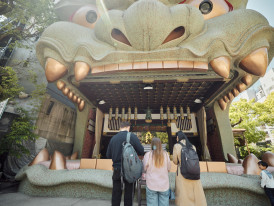
Office workers praying at the shrine.
The Lion Head Guardian
If you like traditional architecture like Osaka Castle, you'll love this next spot I'm recommending.
The shrine's main building features a massive lion head seeming to roar at urban chaos surrounding it. Local people visit to pray for victory in examinations, business ventures, other life challenges.
The lion head is said to swallow bad luck and evil spirits, appropriate given its location in one of Osaka's busiest districts.
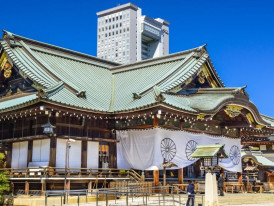
Traditional shrine architecture contrasting with modern buildings.
Urban Meditation Space
Shrine grounds provide a pocket of quiet that amplifies surrounding vibrant city noise. Standing in this peaceful space while hearing traffic, construction, human conversation creates uniquely urban meditative experience.
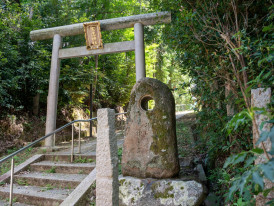
Stone path leading to Tomb of the Nue, surrounded by foliage. Image by David Emrich from Unsplash
The Tomb of the Nue: Osaka's Most Atmospheric Secret
Hidden behind Namba Yasaka Shrine lies one of Osaka's most haunting, lesser-known sites: the Tomb of the Nue. This small monument marks the supposed burial place of a mythical creature.
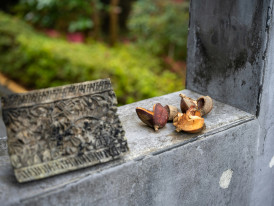
Small offerings left at the Nue tomb. Image by Kouji Tsuru from Unsplash
Mythical Creature Burial Ground
Part monkey, part tiger, part serpent, the creature terrorized the imperial court centuries ago before being defeated by a legendary archer.
The tomb itself is modest - simple stone marker surrounded by overgrown vegetation.
But the atmosphere is unforgettable.
Locals leave small offerings here, and the space maintains mystery feeling genuinely supernatural.
Finding the tomb requires asking directions or following cryptic signs, adding appeal for people enjoying urban exploration. It's not officially promoted as tourist attraction.
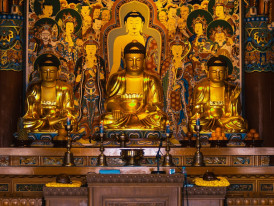
Interior of Isshin-ji Temple with Bone Buddha statues. Image by (っ◔◡◔)っ Clement
Isshin-ji Temple: The Bone Buddhas of Osaka
Few visitors to Osaka know about Isshin-ji Temple's most remarkable feature: Buddha statues made from human ashes.
The temple's practice of incorporating cremated remains into religious sculptures creates artwork both beautiful and deeply unsettling.
The Bone Buddhas represent a uniquely Japanese history approach to death and remembrance. Rather than hiding mortality, the temple grounds celebrate it as part of Buddhist teachings about impermanence.
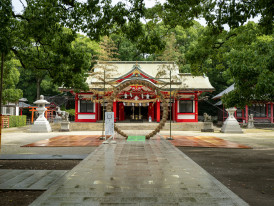
Peaceful temple grounds surrounding Bone Buddha hall. Image by Kouji Tsuru from Unsplash
Sacred and Secular Coexistence
Temple grounds remain peaceful despite being surrounded by residential neighborhoods. The contrast between profound spiritual art inside and everyday life outside creates meditation on how sacred and secular coexist in Japanese culture.
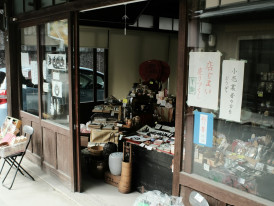
Small vintage shop with handwritten sign. Image by Mak from Unsplash
Treasure Hunting in Used Culture
Osaka's vintage stores offer more than old clothes, they're repositories of Japanese pop culture history. Shops throughout the city specialize in different eras and styles.
Fashion History Education
The best vintage stores are tiny, crammed spaces where special findings require patience and luck. Shop owners often have encyclopedic knowledge of fashion history.
These conversations change shopping into education about Japanese cultural development through the twentieth century.
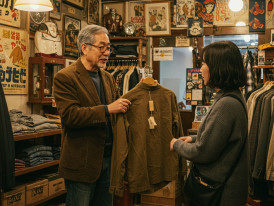
Vintage store owner explaining garment history.
Quality Over Trend
Prices reflect quality rather than novelty. Well-made items command appropriate prices, while trendy pieces from recent decades remain affordable.
Osaka's Unique Urban Rhythm
I wanted to rant about how awesome I think this city is, but I think I do enough to show off everything that's special about it already.
So here's my brief tangent: Osaka boasts an atmosphere unlike any other Japanese city, a blend of industrial grit and culinary sophistication that creates something entirely its own.
Walk through any neighborhood and you’ll feel the real pulse of local life.
Office workers debate which takoyaki stand is best. Elderly shopkeepers arrange their displays with almost mathematical precision.
Teenagers practice dance routines in the covered shopping arcades.
Osaka’s location near the sea means fresh seafood arrives daily at markets across the city.
What really stands out is how locals use these ingredients in everyday meals, especially in street food and casual dining.
This isn’t a city performing for visitors. It lives with energy and unshakable confidence.
The result is an urban experience that feels simultaneously timeless and completely contemporary, rooted in tradition yet constantly evolving.
Theme Park Magic: Universal Studios Japan
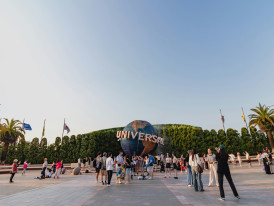
Universal Studios Japan entrance gate. Image by Joshua Tsu from Unsplash
Universal Studios Japan brings American entertainment culture to Japan with characteristic attention to detail and service quality.
The park recreates famous movie sets and experiences.

Harry Potter themed area with Hogwarts castle. Image by Soyoung Han from Unsplash
The Harry Potter Experience
The Harry Potter section deserves particular attention. The Wizarding World of Harry Potter feels more magical here than at other Universal Studios locations, possibly because Japanese attention to detail matches J.K. Rowling's intricate world-building.
Every shop, restaurant, attraction maintains consistency with books and films while adding subtle touches enhancing the fantasy.

Jurassic Park ride with animatronic dinosaur. Image by Mehmet Turgut Kirkgoz from pexels
Multi-Generational Appeal
Jurassic Park attractions combine cutting-edge technology with storytelling appealing to multiple generations. Parents who saw the original film can share experiences with children knowing the franchise through recent movies.
The entrance fee may feel a little steep, but the experience justifies the cost. This isn't carnival rides with movie themes - it's immersive experiences temporarily transporting visitors into fictional worlds.
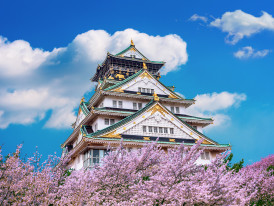
Cherry blossoms framing Osaka Castle.
Cherry Blossom Season: Nature's Annual Performance
During cherry blossom season, Osaka turns into something almost impossibly beautiful. Cherry blossoms appear throughout the city, but the most spectacular displays happen in parks.
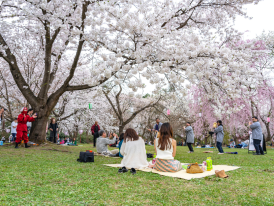
Families having hanami picnic under cherry blossoms.
Osaka Castle Park becomes the epicenter of hanami (flower viewing) celebrations. Thousands gather under blooming trees for picnics, parties, quiet contemplation.
The scene combines reverence for natural beauty with Japanese social rituals in ways feeling both ancient and contemporary.
Impermanence Awareness
The cherry blossom season lasts only a few weeks, creating urgency that intensifies the experience. Everyone knows the flowers will fall soon, adding poignancy to their beauty.
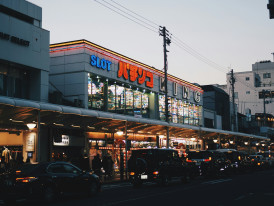
Den Den Town electronics district storefront. Image by Nicholas Ng from Unsplash
Pop Culture Crossroads: Where Anime Meets Reality
Osaka's relationship with pop culture is complex and constantly evolving. The city appears in countless anime, manga, films, but not always as itself.
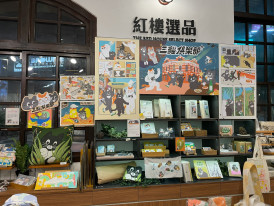
Manga and anime merchandise display. Image by Uncle Lim from Unsplash
Den Den Town, Osaka's electronics and pop culture district, offers everything from vintage video games to latest manga releases. The area attracts serious collectors and casual fans.
Relaxed Pop Culture Approach
Maid cafés exist here, but they're less theatrical than Tokyo versions. The emphasis falls on friendly service rather than elaborate performances, reflecting Osaka's more relaxed approach to pop culture phenomena.
The Osaka That Stays With You
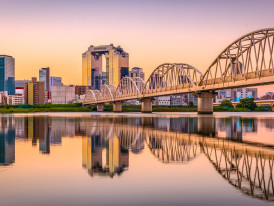
Panoramic view of Osaka at twilight showing urban density.
After writing about all these places, I realize what makes Osaka genuinely cool isn't any single location.
It's the city's ability to be simultaneously ancient and modern, traditional and experimental.
This incredible city contains multitudes without trying to resolve contradictions.
The amazing places I've described exist within walking distance of each other, creating opportunities for spontaneous discovery.
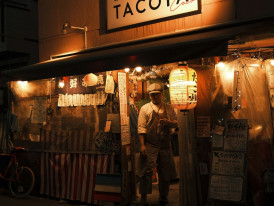
Street vendor serving customers at twilight. Image by jack berry from Unsplash
What I hope you take from this exploration is appreciation for how cities can maintain distinct personalities while embracing change.
This vibrant city continues evolving, but its essential character remains constant, seen in spots like Osaka Castle, Umeda Sky Building, and the many narrow alleys.
Ready to explore these places yourself?
Check out our comprehensive guide to Osaka experiences for detailed information about planning your visit, or find more cool things to do in Osaka that will make your trip unforgettable.

